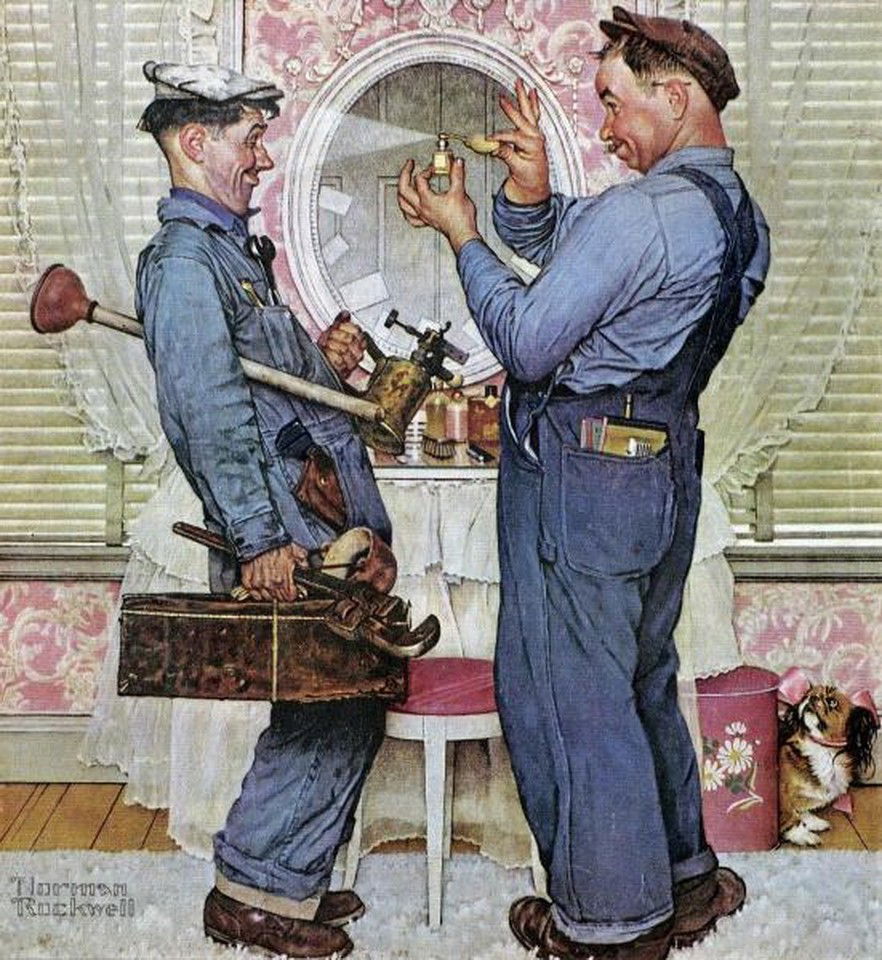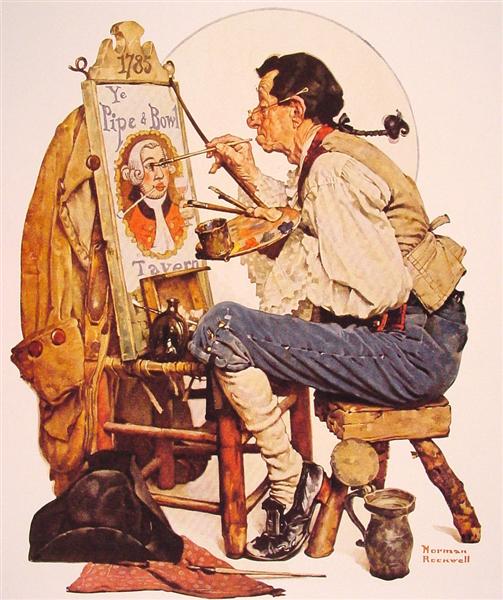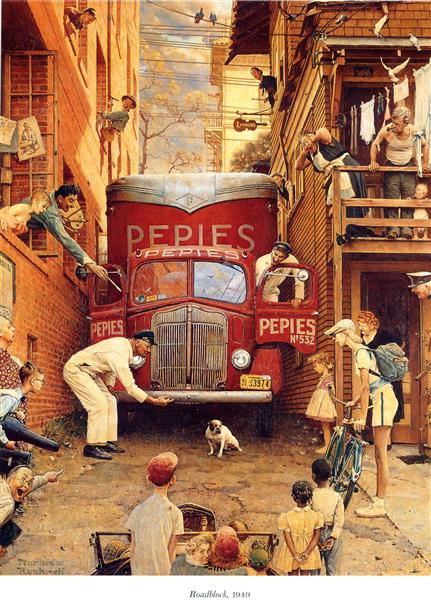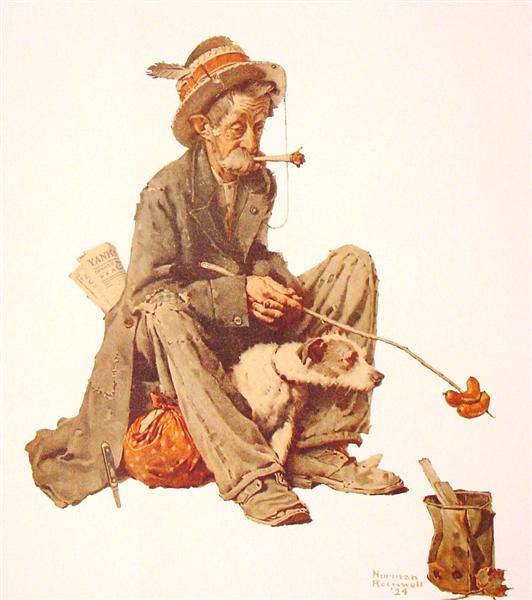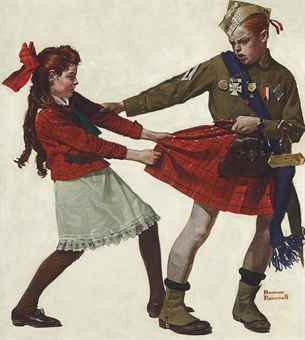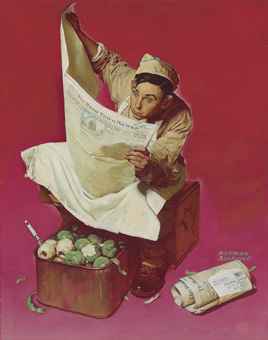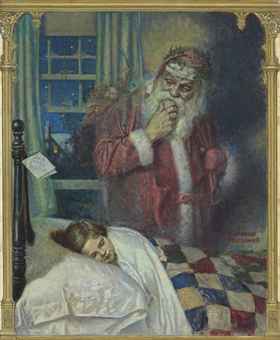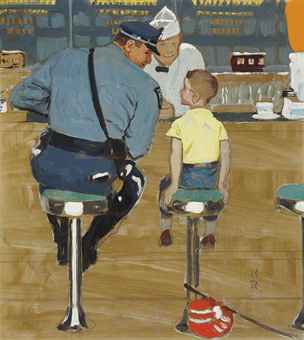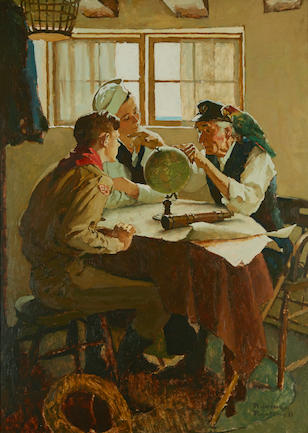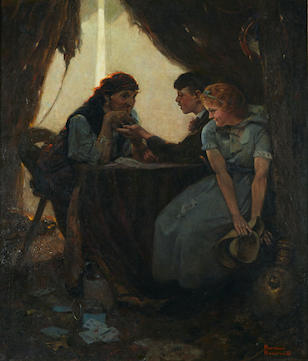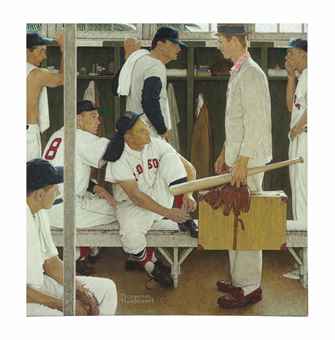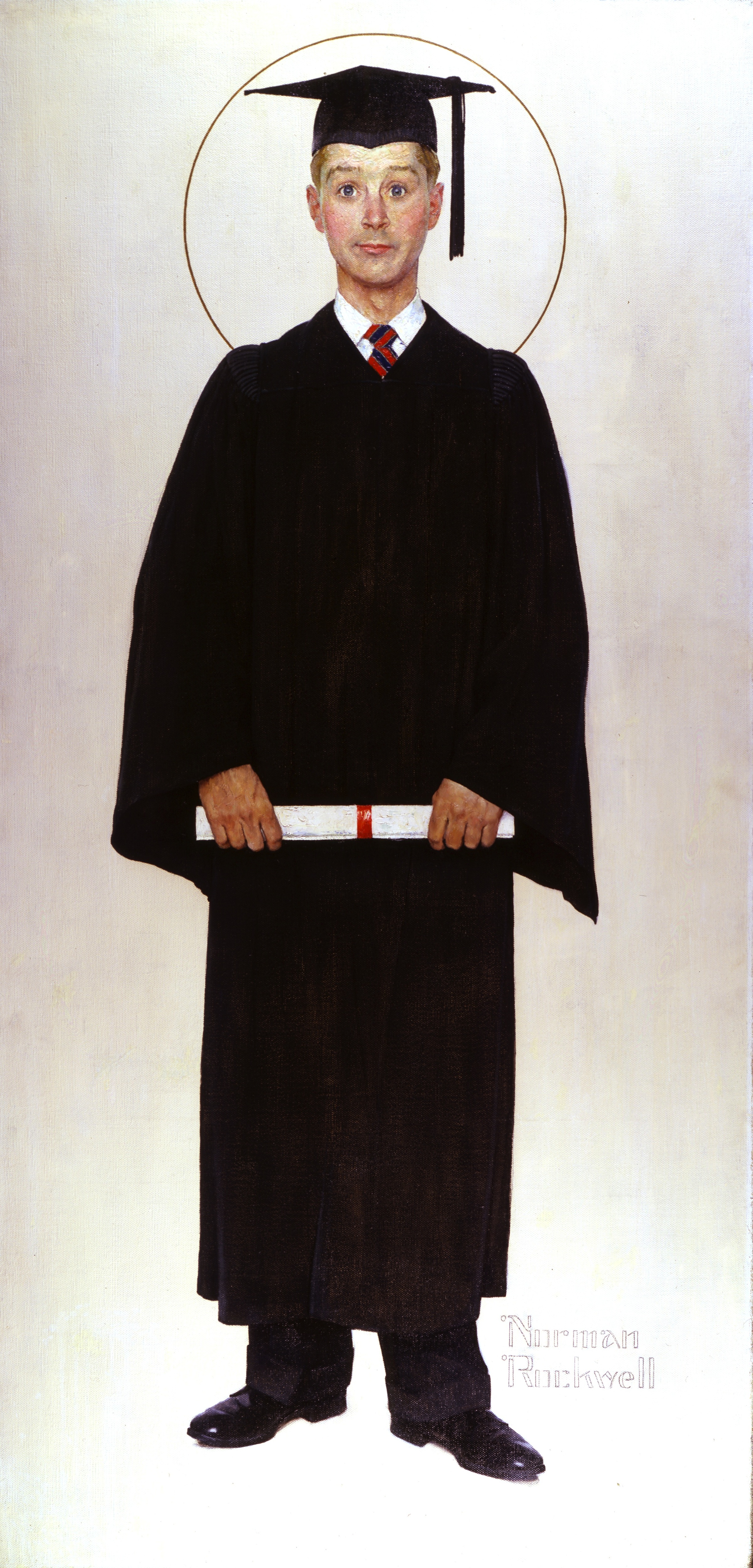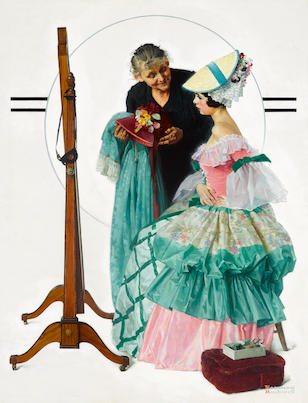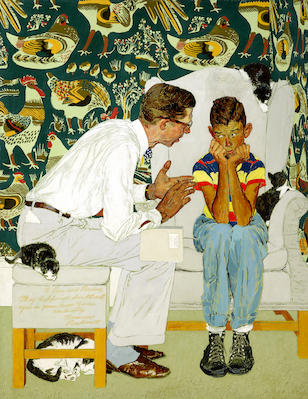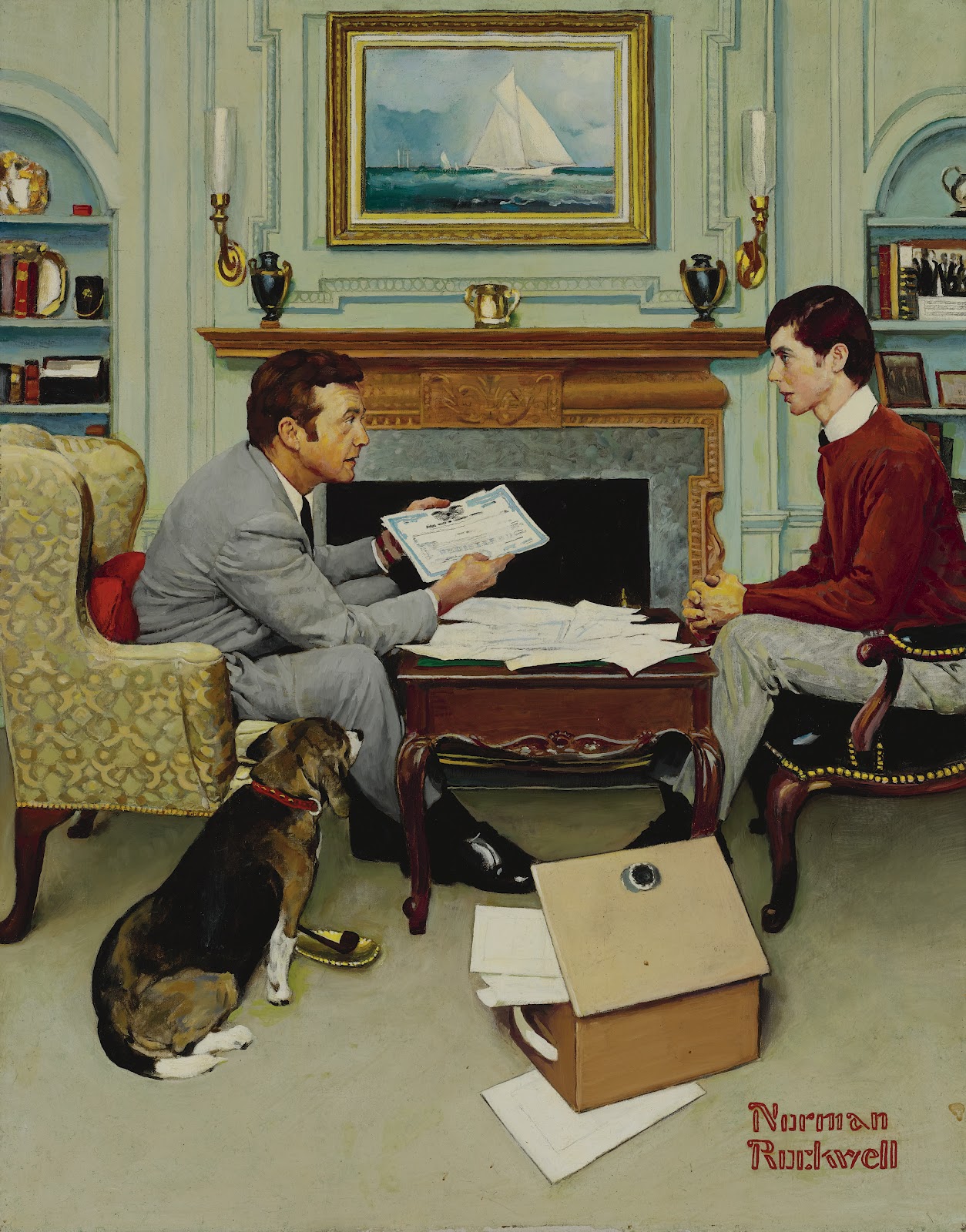Sotheby's 2017
QUINTESSENTIAL NORMAN ROCKWELL
Two Plumbers from 1951 is Norman Rockwell at his best. Created at the height of his career, the painting brilliantly demonstrates the artist’s talent for depicting everyday life with a dose of humor. To produce the current work, Rockwell employed two of his studio assistants – Don Winslow and Gene Pelham – as models, posing them in front of a dresser owned by his wife, Mary. By combining real-life models, who were often friends and neighbors of the artist, and photography, Rockwell was able to meticulously account for each and every detail, which is in part what brings his paintings to life. In his own words: “Now my pictures grew out of the world around me, the everyday life of my neighbors. I don’t fake it anymore”. Sold at Sotheby’s New York in 1996, and having remained in the same private collection since, Two Plumbers returns to the market this season with a pre-sale estimate of $5/7 million.
Sotheby’s New York 21 November 2016 auction of American Art
The sale is headlined by Norman Rockwell’s Saturday Evening Post cover, Which One?
Norman Rockwell’s Which One? (Undecided; Man in Voting Booth) will be a major highlight of our 21 November 2016 auction of American Art in New York. Depicting the public sentiment leading up to the presidential election of 1944 , in which President Franklin Delano Roosevelt ran against Thomas E. Dewey, this painting epitomizes Rockwell’s signature style , combining relatability and intellect, humour and all -American pride.
Acquired by the Phipps Family in the1980s , the painting will be exhibited in New York starting 4 November 2016 alongside Impressionist, Modern & Contemporary Art, before the American Art auction on 21 November, when it is estimated to sell for $4/6 million .
1944: AN ELECTION YEAR
Focused on the United States presidential election of 1944, a hotly -contested race between Democratic President Franklin Delano Roosevelt, running for his fourth term, and Republican Thomas E. Dewey, governor of New York, Which One? is a superb example of Norman Rockwell’s ability to highlight issues at the forefront of national discourse in a relatable manner. With questions of foreign and domestic policy, as well as the general health of the incumbent, being called into question, Americans rallied to vote, taking part in an essential, American experience. In Which One? a Cedar Rapids resident represents the millions of undecided voters across the country. Having educated himself with political pamphlets and newspapers, the former jammed in his pocket and the latter still grasped in his hand, the voter continues to weigh his options. While the image alone would have resonated with citizens throughout the United States, Norman Rockwell’s keen attention to detail, demonstrated by the fine print of The Cedar Rapids Gazette and the man’s bemused expression , bring s this undecided voter to life.
Furthermore, by balancing the composition and creating a sense of depth, one feels that he or she could step into the painting and into the shoes of the Cedar Rapids voter. Which One? (Undecided; Man in Voting Booth) embodies the best of Norman Rockwell and his ability to capture American life. Having been in the same collection for over three decades, the November auction of American Art offers a rare opportunity for collectors and institutions to acquire a quintessential work by one of America’s most beloved painters of the 20th Century.
NORMAN ROCKWELL: AMERICA’S STORYTELLER
Norman Rockwell was, and continues to be, America’s storyteller. Best known for his covers for The Saturday Evening Post, his works of art captured the zeitgeist of the day, including patriotism, racism and national security. In fact, with the public’s reliance on daily newspapers and weekly magazines like The Post for information and regular updates, his paintings were an integral part of the conversation. Capturing them with warmth, w it and a sense of humor, Norman Rockwell appealed to the average American. In the words of Thomas S. Buechner, “because [Rockwell] illustrates them using familiar people in familiar setting with wonderful accuracy, he continue to grow as new generations live through the same quintessentially American types of experiences that he so faithfully depicted in his art” (Norman Rockwell: A Sixty Year Retrospective, New York, 1972, p. 13).
Additional significant Rockwells on offer this November include
Pipe and Bowl Sign Painter (estimate $1.5/2.5 million )
and Organist Waiting for Cue (estimate $1.2/1.8 million) ,
both strong examples of the artist’s work for The Post in the 1920s. Remarkably, the former was the first image to appear on the cover of the publication in full color.
Sotheby’s American Art 18 May 2016
Among the most sophisticated and complex compositions Rockwell created for the cover of The Saturday Evening Post, Road Block (estimate $4–6 million) demonstrates the artist’s distinctive sense of humor and unparalleled gift for storytelling–two of the qualities that have incited comparisons between Rockwell’s work and filmmaking. Regarding his 1949 painting Road Block, NormanRockwell bemoaned: “Why, oh, why do I paint such involved and complicated pictures?”
The May sale also will include Rockwell’s Hobo and Dog (estimate $1.5–2.5 million), sold by The Metropolitan Museum of Art. Appearing on the cover of The Post on October 18, 1924, it features one of Rockwell’s favorite models of the period: James K. Van Brunt.
Sotheby's May 2015
NORMAN ROCKWELL’S THE BOOKWORM , FROM THE WARSHAWSKY COLLECTION
Sotheby’s will present The Warshawsky Collection – a landmark offering of Tiffany, Pre-War Design and fine art – this May in New York, assembled from the 1960s through the ‘90s by noted Chicago businessman Roy Warshawsky and his wife Sarita. The collection is led by Norman Rockwell’s The Bookworm from 1926, which is considered a tribute to German artist Carl Spitzweg’s painting Der Bücherwurm from 1852 (estimate $1.5–2.5 million). Rockwell’s homage reverses the stance of the original painting both literally and figuratively: whereas Spitzweg depicts a respectably-dressed German burgher in a large library, Rockwell paints an eccentric and absentminded reader lost amongst his findings at an outdoor bookstand.
NORMAN ROCKWELL’S THE BOOKWORM , FROM THE WARSHAWSKY COLLECTION
Sotheby’s will present The Warshawsky Collection – a landmark offering of Tiffany, Pre-War Design and fine art – this May in New York, assembled from the 1960s through the ‘90s by noted Chicago businessman Roy Warshawsky and his wife Sarita. The collection is led by Norman Rockwell’s The Bookworm from 1926, which is considered a tribute to German artist Carl Spitzweg’s painting Der Bücherwurm from 1852 (estimate $1.5–2.5 million). Rockwell’s homage reverses the stance of the original painting both literally and figuratively: whereas Spitzweg depicts a respectably-dressed German burgher in a large library, Rockwell paints an eccentric and absentminded reader lost amongst his findings at an outdoor bookstand.
Christie’s 19 November 2014
STOLEN GOODS (BOY STEALING GIRL'S KILT)
$800,000 - $1,200,000
Painted in 1918, Stolen Goods is exemplary of the signature wit and charm found in Rockwell’s best work. Stolen Goods was featured on the cover of the February 9th, 1918, issue of Judge Magazine, a satirical publication launched by artists in 1881.
Christie’s December 5, 2013
Among the five works in the sale by Norman Rockwell is The Thing to Do
With Life is Live It! (Outrigger Canoe) (estimate:
$800,000-1,200,000). Rockwell painted the seven-foot-wide canvas in 1956
after having been approached by an advertising agency to create a campaign for
Pan American World Airlines. The ads sought to highlight the breadth and
diversity of Pan Am’s tourist destinations and featured a variety of
international locales, including London, Rome, Tokyo, and Hawaii. The
charming and humorous painting offered in the sale is a true celebration of
American tourism. An uneasy couple wearing matching Hawaiian shirts and straw
hats are juxtaposed with the confident native Hawaiians, who aggressively
paddle their Outrigger Canoe through the waves. In Rockwell’s only known
portrayal of Hawaii, he succeeded in obliging the demands of his advertising
commission, while still maintaining his trademark sense of humor.
Christie’s 28 November 2012
Deer Santy Claus by Norman Rockwell was believed to have been lost or discarded over eighty
years ago, but was unexpectedly found in a closet in California this past May.
( estimate: $300,000-500,000). Commissioned for the
Western Newspaper Union syndicate in 1921, the painting depicts a young girl
fast-asleep in her bed under a patchwork quilt in the foreground, with a letter
addressed “Deer Santy Claus” tied to her bedpost. Santa Claus, dressed in
his traditional red suit and hat, peers over the child, his hand is placed on
his bearded chin as he contemplates what gift he should give her for the
holiday. The painting evokes the sense of innocence nostalgia with which
Norman Rockwell is so closely associated.
CHRISTIE’S
September 25. 2012
-
Norman Rockwell’s Study for ‘The
Runaway’ leads the sale (estimate: $80,000 – $120,000). Arguably the
artist’s most iconic image, the completed work was used as a Saturday
Evening Post cover for the September 20, 1958 issue. The scene
features a young boy who has packed up all of his belongings into a neatly
folded knapsack and run away from home. Before setting out on his
adventure, he stops at a local diner only to find himself caught up in a
conversation with a friendly policeman, who is earnestly asking him to
reconsider his departure. As is the case with most of Rockwell’s artwork,
he found models among the locals in his town. Richard Clemens, a
29-year-old trooper and neighbor of the artist in Stockbridge was asked to don
his uniform and meet at a local restaurant. There he was introduced to an
8-year-old boy, Eddie Locke, who had been recruited from a nearby elementary
school. Originally, the Saturday Evening Post acquired the
study directly from the artist, and upon the retirement of the present owner’s
mother from her longstanding job at the Post, the work was given to her.
It has remained with the family for many years and has since been given to the
current owner by his mother.
Also featured in the sale is Rockwell’s Study
for ‘A Man’s Wife,’ an illustration completed to accompany a story
written by Howard Fast in the February 1939 issue of Ladies’ Home Journal (estimate:
$30,000 – $50,000). The story fictionally chronicled the lives of Martha
and George Washington in the camp at Valley Forge. Rockwell was gifted in
that he was able to choose the correct moment in the story for the
illustration, creating enough of an interest in the viewer for them to read the
story. The scene that Rockwell chose to illustrate is the moment when
Martha Washington enters the kitchen to find that the supper she had planned to
serve to Colonel Hamilton has been burned and is now inedible. Knowing that
food is scarce, the kitchenmaid is distraught by her mistake and is found
weeping on a bench. When Martha asks why the meal is ruined, a sentry who
had been stationed outside the house, rushes in and jumps to the young girl’s
defense, appealing to the romantic sensitivities of the female readers.
The study was given by the artist directly to his friend and barber, Steven M.
Kovac, whose name appears in the dedication at lower right. The picture has
remained in the family ever since.
Swann Galleries June 12 2014
The Family Tree,
charcoal, drawn for the cover of The Saturday Evening Post’s October 24, 1959 issue
(see a great history of this work here)—which was accompanied by a copy of the magazine, $28,160.
Christie’s May 22, 2014
| The Rookie illustration ©SEPS. Used with permission from Curtis Licensing, Indianapolis, Indiana. All Rights Reserved |
The work was painted in 1957 for the March 2nd cover of The Saturday Evening Post and has remained in the same private collection for nearly thirty years. It has been publicly exhibited at the Museum of Fine Arts, Boston twice–once in 2005 and again in 2008–following World Series victories by the Red Sox. Estimated at $20-30 million, The Rookie (Red Sox Locker Room) marks the highest estimate ever for Norman Rockwell at auction.
Norman Rockwell’s covers for The Saturday Evening Post during the 1950s reflected the direction of editor Ben Hibbs, who strove to make the magazine more current to increase circulation. Nothing could be a more popular subject to an American audience than baseball and no player other than Ted Williams, “The Greatest Hitter Who Ever Lived” was commanding more attention at the time, on the eve of his retirement from baseball. Rockwell conceived this cover at least 9 months in advance of its publication date on March 2nd, 1957, just in time for the start of spring training for the Red Sox.
Over the summer of 1956, he convinced team management to send four players from the starting lineup up to Rockwell’s hometown, Stockbridge, Massachusetts, deep in Red Sox country. Pitcher Frank Sullivan, right fielder Jackie Jensen, catcher Sammy White all posed for the painting. Williams was either unable or unwilling to make the trip and Rockwell captured his likeness from his trading card, and other photographs. Rockwell traveled to Sarasota to take pictures of the Red Sox spring training stadium and locker room. The palm trees which sway in the window indicate the location. The Rookie (Red Sox Locker Room) depicts an intimate scene during spring training; an awkward newcomer is juxtaposed with the confident stances of the seasoned players, making the rookie’s anxiety all the more apparent and endearing.
In addition to The Rookie (Red Sox Locker Room), ten other works by Norman Rockwell will be offered in the sale, including
The Collector ( estimate: $700,000-1,000,000),
Boy Graduate (estimate: $2,000,000-3,000,000)
and Willie Gillis in Church (estimate: $2,000,000-3,000,000).
SOTHEBY’S DEC 4 2013
Estimate 200,000 — 300,000
Lot Sold 905,000
Estimate 15,000,000 — 20,000,000
Lot Sold 46,085,000
Estimate 200,000 — 300,000
Lot Sold 329,000
Estimate 6,000,000 — 9,000,000
Lot Sold 8,453,000
Estimate 3,000,000 — 5,000,000
Lot Sold 3,245,000
Estimate 200,000 — 300,000
Lot Sold 509,000
Estimate 100,000 — 150,000
Lot Sold 137,000
Norman
Rockwell’s Under the Mistletoe was
painted in 1936 for the December 19thcover
of The Saturday Evening Post(est. $600/800,000). Though Rockwell painted over
300 covers illustrations for The Saturday Evening Post during his forty-seven
year career with the publication, his most beloved works were his holiday-themed
covers. Under the Mistletoec aptures
an intimate but playful moment between a travelling gentleman and a barmaid as
he bends forward for a kiss under the mistletoe.
Bonham's December 4, 2013
Iconic works by Norman Rockwell lead the sale. Girl Choosing Hat, which was the cover for the January 31, 1931 edition of the Saturday Evening Post is the auction's top lot, executed at the start of Rockwell's most fruitful years at the magazine (est. $400,000-600,000). This work comes to sale directly from the artist's family.
CHRISTIE’S 23 MAY 2013
A quintessential oil on canvas by Norman Rockwell is just one of the many illustrations that will be offered on May 23. Starstruck (estimate: $800,000-1,200,000) was painted for the September 22, 1934 cover of The Saturday Evening Post and depicts a young boy fawning over Hollywood’s leading ladies of the day. Distracted by the beautiful movie stars, the boy has cast aside his childish pursuits of baseball and playtime with his faithful sidekick. The fact that both the boy and his dog are pining for the attention of an unwitting subject underscore the scene’s charm.
- The enduring strength of the market for works by Norman Rockwell was felt throughout the sale – the six examples on offer together sold for an impressive $6.5 million, more than double their overall high estimate of $3 million. Seven bidders battled for

He’s Going to Be Taller than Dad, a domestic scene of a boy and his faithful dog that fetched $2,629,000 (est. $500/700,000). (This follows Sotheby’s November 2012 sale of American Art in which five works by Rockwell totaled $6.1 million, again demonstrating the continued appetite for works by the American icon.)
More sales – Sales price and estimate:

Norman Rockwell, Doc Melhorn and the Pearly Gates, 1938 $1,085,000 (£716,266) $1,000,000 - 1,500,000

Norman Rockwell, Sport, 1939 $905,000 (£597,439) $300,000 - 500,000

Norman Rockwell, The Veterinarian, 1961 $845,000 (£557,829) $200,000 - 300,000
The Muscleman (1941) sold for $2,210,500 (high estimate: $800,000)
and Doctor and Doll (1942) reached $1,874,500 (high estimate: $700,000).
Sotheby’s May 17 2012
Estimate 150,000 — 250,000
Lot Sold 170,500
Estimate 150,000 — 250,000
Lot Sold 422,500
Estimate 300,000 — 500,000
Lot Sold 332,500
Estimate 150,000 — 250,000
Lot Sold 242,500
Sotheby’s May 17 2012
